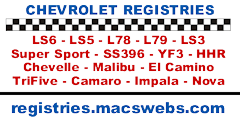|
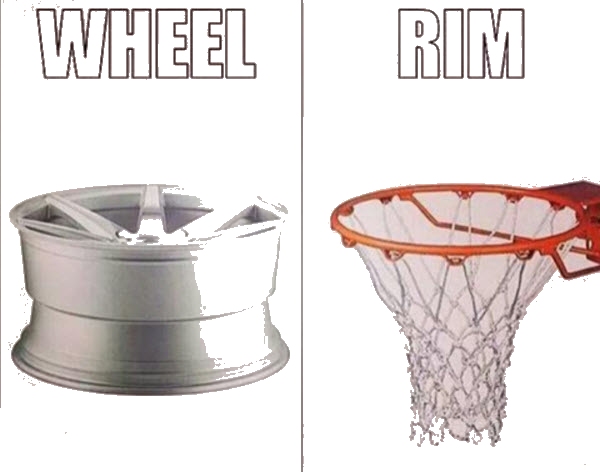
WHEEL: noun
A circular object that revolves on an
axle and is fixed below a vehicle or other object to
enable it to move easily over the ground
RIM:
noun
The upper or outer edge of an object, typically
something circular or approximately circular
Neither hub caps nor wheel covers
have any effect on a wheel's backspacing/offset.
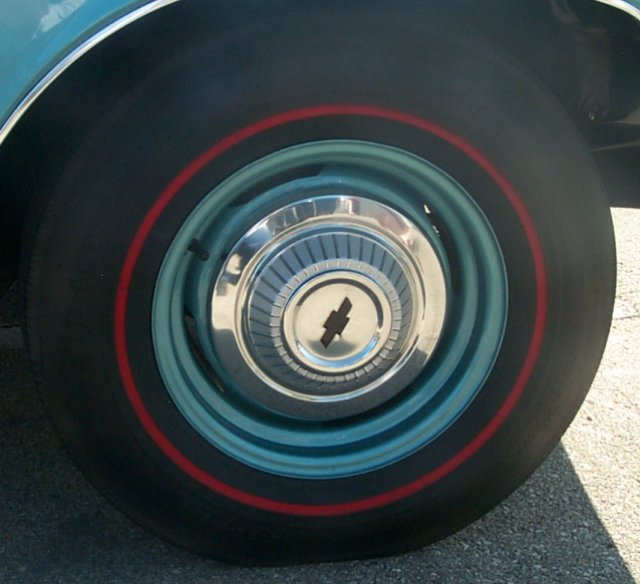
This is a hub cap. A hub cap is standard equipment on
all cars except 1967 Chevelles with disc brake option,
Chevelle SS-specific (1969-1972) wheels, and 1964-1965
Malibu SS Chevelles with full wheel covers. Often called
"dog dish," "poverty caps," "police caps," etc. simply
because the car was not ordered with full wheel covers.
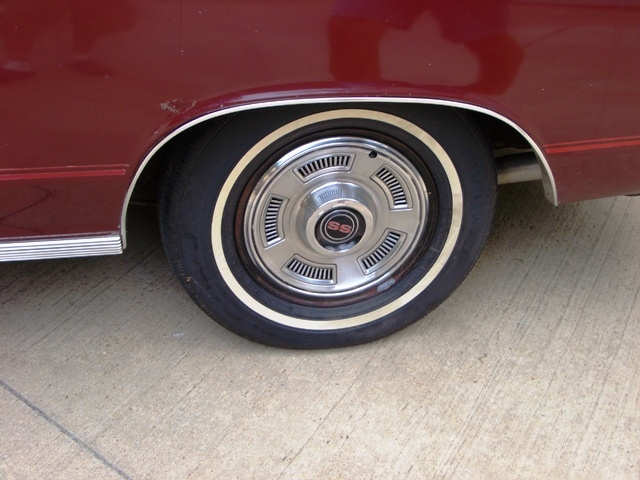
This is a wheel cover, not a hub cap. These are optional
on all Chevelles except those with optional rally wheels,
SS-specific (1969-1972) wheels. Often a model year may have several optional wheel
covers available.
Offset and backspacing are two commonly used terms in
wheel measurement but can be confusing at times. While
the terms are related, many people will ask what is the
best, or most, backspacing I can use to fit a particular
wheel/tire combination. Unfortunately, most wheel
manufacturers use offset for a measurement and not
backspacing. Let's try to clear up this often
misunderstood terminology and learn how to measure
offset and the resulting backspacing.
Advertised
wheel width is generally measured at the inside tire
bead mounting surface but you must determine the overall
wheel width from the front to rear lip - usually 1-inch
total. So a wheel that is advertised as 16x8 is
16-inches in diameter, 8-inches from tire bead to tire
bead but 9-inches wide overall.
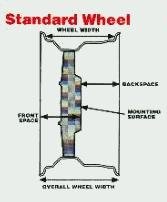
0-inch offset - Backspacing is determined by the wheel's
width from bead to bead.
Offset ~ The distance from the
mounting pad to the centerline of the wheel. Offset can
be positive (more backspacing) or negative (less
backspacing).
Backspacing ~ The
measurement from the mounting pad to the inner edge of
the wheel.
(These are definitions supplied by
ARE. Other wheel manufacturers may use different points
of measurement.)
Let's assume you have a
17x8-inch wheel. Lay the wheel on the ground with the
front (street side) facing down. Lay a straight edge
across the rear (top) lip and measure from this lip to
the mounting flange. If the wheel has "zero" offset,
this will measure about 4.5 inches - one half the width
of the wheel plus the wheel lip width (approx. 0.5") and
result in a 4.5-inch backspace. (Again, ARE measures
differently. A 17x8 ARE 200S with zero offset has 4.5"
of backspacing to the inner edge of the wheel and not to
the bead.)
Negative Offset (less backspacing)
If you remember the days of the 'deep-dish' or
chrome-reverse wheels, you've seen negative offset. The
mounting flange of the wheel is moved from the
centerline towards the car itself resulting in the wheel
having a greater lip surface towards the outside. Not
only does this reduce the clearance between the tire and
the wheel well lip for your tires, it puts more strain
on the wheel and axle bearings.
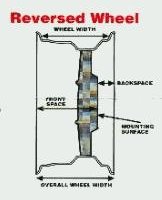
Negative offset equals less backspacing.
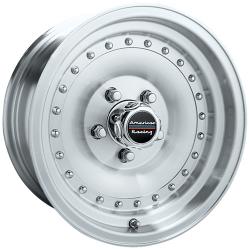
The American Racing Outlaw I model wheel is a good
example of a wheel with negative offset. In a 15x8 size
this wheel is listed as having -19mm offset
resulting in 3.75-inches of backspacing.
Let's see how this is arrived at.
* 8-inch wheel
is 9-inches from lip to lip.
* One-half of 9-inches
is 4.5-inches.
* -19mm offset is roughly
-0.75-inches.
* Add the -0.75-inches offset to the
mounting surface location of 4.5-inches and you get
3.75-inches of 'backspacing'
Positive Offset (greater
backspacing)
Positive offset can be seen on many of today's modern
cars with front wheel drive. The centerline of the wheel
is moved towards the front (street side) resulting in
more backspacing. With disc brakes and wider tires being
standard equipment, the positive offset allows the
wheel/tire combination to fit inside the wheel well
instead of protruding past the fender lip. This wheel
has a positive offset of over 40mm thereby moving the
mounting flange over 1.5-inches toward the street side
of the wheel.
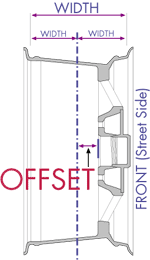
Positive offset equals greater backspacing
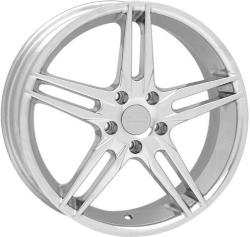
The American Racing Split model wheel is a good
example of a wheel with positive offset. In a 15X7 size
this wheel is listed as having +40mm offset
resulting in 5.5-inches of backspacing.
Let's see how this is arrived at.
* 7-inch wheel
is 8-inches from lip to lip.
* One-half of 8-inches
is 4-inches.
* +40mm offset is roughly 1.575-inches.
* Add the 1.575-inches offset to the mounting surface
location of 4-inches and you get 5.575-inches of
'backspacing'
These terms can be confusing at
times as some manufacturer's list the backspacing, some
list offset, and some list both. Just remember that
backspacing is a direct result (or byproduct) of offset.
Many wheel manufacturers also list backspacing or
offset in millimeters instead of inches, so a little
math conversion comes into play here.
For the
Chevelle owner with a 5 lug, 4.75-inch bolt circle wheel
pattern, two 17x8 models of the ARE 200S wheel are
offered; one with +14mm offset and one with -12mm
offset. I use this wheel as an example only because I
had a set of these and, personally, I prefer ARE wheels.
Be sure to check with your choice of wheel companies to
see how their offset/backspacing is measured.
First we must learn to deal with the metric measurements
and convert those to inches. Multiply the metric
measurement by 0.03937 to get the
measurement in inches. For example: +14mm is equivalent
to 0.55 inches. The +14mm is a positive offset of 0.55
inches so that will move the mounting flange 0.55 inches
closer to the front of the wheel resulting in a
5.05-inch backspacing - much like the OFFSET picture at
the top of the page. The other wheel has a -12mm offset
(negative) that calculates to 0.4724 inches.
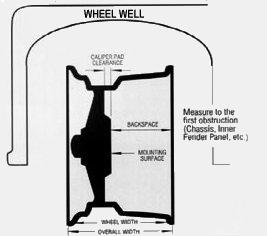
The negative offset will move the mounting flange
closer to the back of the wheel resulting in less
backspacing; 4.0276 inches (4.50 - .4724) in this case.
Negative offset gives the wheel that "deep dish" look
but can play havoc with the wheel well and front wheel
bearings.
The published figures by ARE for this
wheel are:
17x8 w/+14mm offset ~ 5" backspacing
17x8 w/-12mm offset ~ 4" backspacing
The American
Racing wheel website has some very good technical
articles explaining offset, backspacing, how to measure,
and how to decide on the correct wheel for your
application.
Practical example using a
Chevrolet 14x5 steel wheel.

The advertised width, 5-inches, is measured from
bead-to-bead, not from the outer edges of the rim. The
wheel measures 6-inches from outside edge-to-outside
edge. Knowing this outside width is important for a
couple of reasons. First, to measure the backspace, (or
offset), this outer edge is used as a reference point.
Second, when the wheel and tire are installed on the
car, this extra 1-inch plus must be taken into account
for clearance.

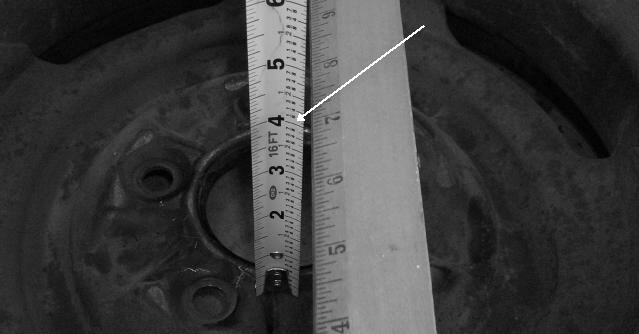
Laying the wheel (without a tire) face down on a
level surface, lay a straight edge across the back side
of the wheel. Measure from the wheel-to-drum/disc
mounting pad to the straight edge. In this example, the
measurement is 4-inches.
To calculate backspacing
or offset, you take the overall wheel width of 6-inches
(from edge-to-edge) and divide that by 2 to find the
centerline of the wheel. In this case, half of 6-inches
is 3-inches. The backspacing is the 4-inches shown in
the photo above. That 4-inch backspacing results in
1-inch offset from the centerline of the wheel. Since
the offset is towards the outside of the wheel, moving
the wheel/tire closer to the suspension, this offset is
considered to be a positive (+) offset.
If the
4-inches shown above were instead, say 2-inches, the
backspacing would be that 2-inches and the offset would
still be 1-inch but it would be a negative (-) offset
putting the wheel/tire combination closer to the wheel
well edge and away from the suspension. In days gone by
this negative offset was called a 'reversed' wheel' or
'deep dish' design.
Linear metric
conversion calculator.
Tire Size to Wheel Size
Many people often ask what size tire can I safely
mount on my wheel? The chart below shows 'recommended'
tire sizes for a particular width wheel. Noting is
absolute. The column heading are the wheel's width and
tire profile. The tire's aspect ratio is shown for each
profile. Be cure to take the wheel's offset when
considering a wheel/tire combination. For example an
8.5-inch wheel can comfortably handle a 235 or 245 tire
with aspect ratios of 30, 35, and 40 (e.g., 255/40R15) and a 265 or 275
tire with an aspect ratio of 60, 65, or 70 (e.g.
285/60R15). The wheel diameter is not relevant.
| Wheel Width (in inches) |
25 |
30, 35, 40 |
45 |
50, 55 |
60, 65, 70 |
75, 80 |
| 3.5 |
- |
- |
- |
- |
- |
125, 135 |
| 4 |
- |
- |
- |
- |
135 |
145 |
| 4.5 |
- |
- |
- |
- |
145, 155 |
155, 165 |
| 5 |
- |
- |
- |
155, 165 |
165 175 185 |
175, 185 |
| 5.5 |
- |
- |
165 |
175 |
185 |
195, 205 |
| 6 |
- |
- |
175, 185 |
185, 195 |
195, 205 |
215, 225 |
| 6.5 |
- |
- |
195 |
205 |
215, 225 |
235 |
| 7 |
- |
195 |
205, 215 |
215, 225 |
235, 245 |
245, 255 |
| 7.5 |
- |
205, 215 |
225 |
235, 245 |
255 |
265 |
| 8 |
- |
225 |
235, 245 |
255 |
265, 275 |
- |
| 8.5 |
- |
235, 245 |
255 |
265, 275 |
285, 295 |
- |
| 9 |
255 |
255 |
265, 275 |
285 |
305 |
- |
| 9.5 |
- |
255, 265, 275 |
285 |
295, 305 |
315 |
- |
| 10 |
275 |
285 |
295 |
- |
- |
- |
| 10.5 |
285, 295 |
295 |
305, 315 |
- |
- |
- |
| 11 |
305 |
305, 315 |
- |
345 |
- |
- |
| 11.5 |
315 |
325, 335 |
- |
- |
- |
- |
| 12 |
325, 335 |
335, 345 |
- |
- |
- |
- |
| 12.5 |
345 |
- |
- |
- |
- |
- |
| 13 |
355 |
- |
- |
- |
- |
-- |
|


Mac's Registries
More Mac's Registries
See more about Chevrolet/Camaro/Monte Carlo/Nova/HHR/SSR/Acadian/Beaumont registries
here ↓

Chevrolet Clubs

|

















